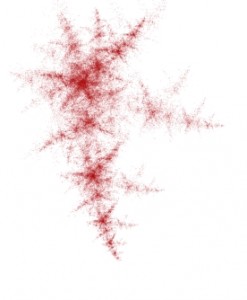
simple fractal
One of the nice things about these images is that they give me the opportunity to talk about some of the more abstract mathematical concepts in a natural environment. These images are rough and don’t look anything like the functions from algebra and calculus, but the are built out of those same simple functions.
The first thing I’d like to talk about is continuity. These images lack many features that I would consider important for a shape. They don’t have distinct edges, sides or middles. Some are just groups of distinct blobs and others are nebulous clouds which don’t look much like anything at all.
In spite of that each one has a well defined “size” and it is possible to overlay two shapes, subtract one from the other and compute the “size” of the difference. This gives a basic concept of distance between the shapes.
One of the neat things about this distance is that you can show the shape generated by these equations depends continuously on the parameters of the equations, so changing one of the numbers slightly produces a correspondingly small change in the shape. That’s what inspired my next page, a random path through a small image space over time.
The images slowly blend and blur into each other over time without jumps or tears, precisely because of that continuity.